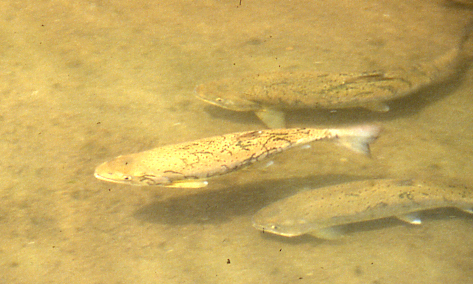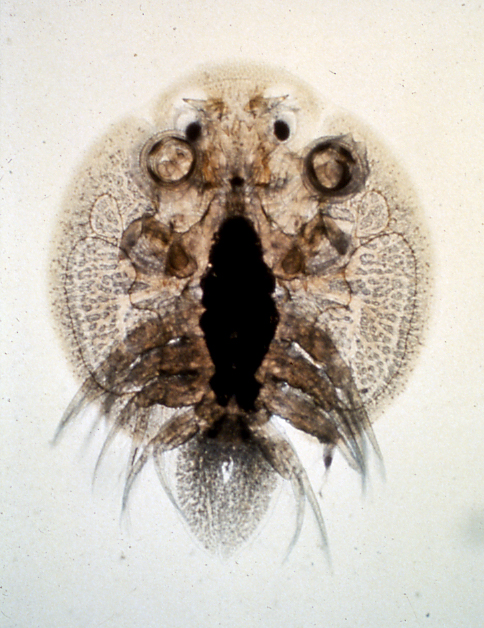

Fig. 2. Female of A. coregoni.
(Photos by S. Morikawa (1) and S. Shimura (2))

| Parasite | Argulus coregoni |
|---|---|
| Taxonomy | Arthropoda, Maxillopoda, Arguloida |
| Hosts | Rainbow trout (Oncorhynchus mykiss), masu salmon (Oncorhynchus masou mosou), red-spotted masu salmon (Oncorhynchus masou ishikawai), ayu (Plecoglossus altivelis), goldfish (Carassius auratus) |
| Disease name | Argulosis |
| Infection site | Skin |
| Clinical signs | Parasites (ca. 1 cm) are observed on the skin. Infected fish exhibit inflammations and haemorrhages in the lesions (Fig. 1). Fungus diseases sometimes occur in the wounded lesions. |
| Parasitology | Argulus coregoni is a crustacean parasite infecting to the skin of cold water fishes. The body (length in female: 7.0-11.1 mm; male: 7.0-9.3 mm) is flat and spherical. It attaches the host’s body surface by the hook-shaped first antenna and the suckers derived from the maxillules. The parasite has a strong swimming ability because 4 well-developed swimming legs are located in the thorax. A female detaches the host and lays egg clusters in pond-wall and waterweed. In Okutama, Tokyo, adults deposit eggs from July to December followed by their death, and only eggs overwinters (Shimura, 1983). Eggs hatch on about 5 weeks at 20 C. |
| Pathology | The lesions become inflamed and haemorrhagic since Argulus coregoni pierces the host’s skin with a preoral sting and injects toxic substances followed by feeding the leaked blood with a proboscis-like mouth. Shimura et al. (1983a) reported that heavily infested (hundreds of parasites) 1-year masu salmon exhibited decreases of the erythrocyte count and the haemoglobin concentration due to the heamorrhages and the blood-feeding by the parasite. Infected masu salmon is susceptible to furunculosis (Shimura et al., 1983b). |
| Health hazard | Since this parasite is not infectious to human, it is harmless in food hygiene. |
| Diagnosis | Argulus japonicus, a similar parasite to A. coregoni, has also been known in Japan. The former infects to warm water fishes, while the latter infects to cold water fishes. A. japonicus can be morphologically differentiated from A. coregoni since the former is smaller and possesses a blunt end of the abdomen. Mixed infection of these two species has not been reported (Ogawa, 2004). |
| Other information | The parasite is effectively removed by the trichlorfon at 50-100 ppm for 30 min or 200 ppm for 20 min (Inoue et al., 1980). Alternatively, A. coregoni can be removed from the culture pond by the attachment board because the parasites preferably deposit their eggs on them. |
| References | Inoue, K., S. Shimura,
M. Saito and K. Nishimura (1980): The use of trichlorfon in the control of Argulus coregoni. Fish Pathol., 15, 37-42. Ogawa, K. (2004): Metazoan diseases. Infectious and parasitic diseases of fish and shellfish. (ed. by Wakabayashi, H. and K. Muroga), Koseisha Koseikaku, pp.381-405. Shimura, S. (1983): Seasonal occurrence, sex ratio and site preference of Argulus coregoni Thorell (Crustacea: Branchiura) parasitic on cultured freshwater salmonids in Japan. Parasitology, 86, 537-552. Shimura, S., K. Inoue, K. Kasai and M. Saito (1983a): Hematological changes of Oncorhynchus masou (Salmonidae) caused by the infection of Argulus coregoni (Crustacea: Branchiura). Fish Pathol., 18, 157-162. Shimura, S., K. Inoue, M. Kudo and S. Egusa (1983b): Studies on effects of parasitism of Argulus coregoni (Crustacea: Branchiura) on furunculosis of Oncorhynchus masou (Salmonidae). Fish Pathol., 18, 37-40. |
Fig. 1. Red spotted masu salmon parasitized by A. coregoni. Parasite bites are observed on the skin.